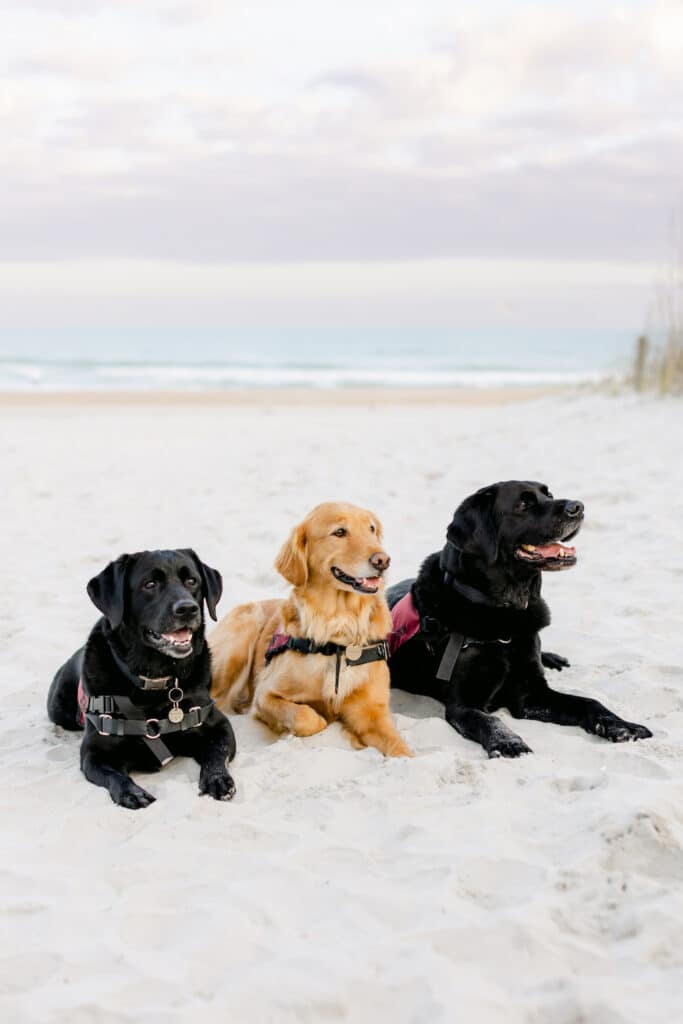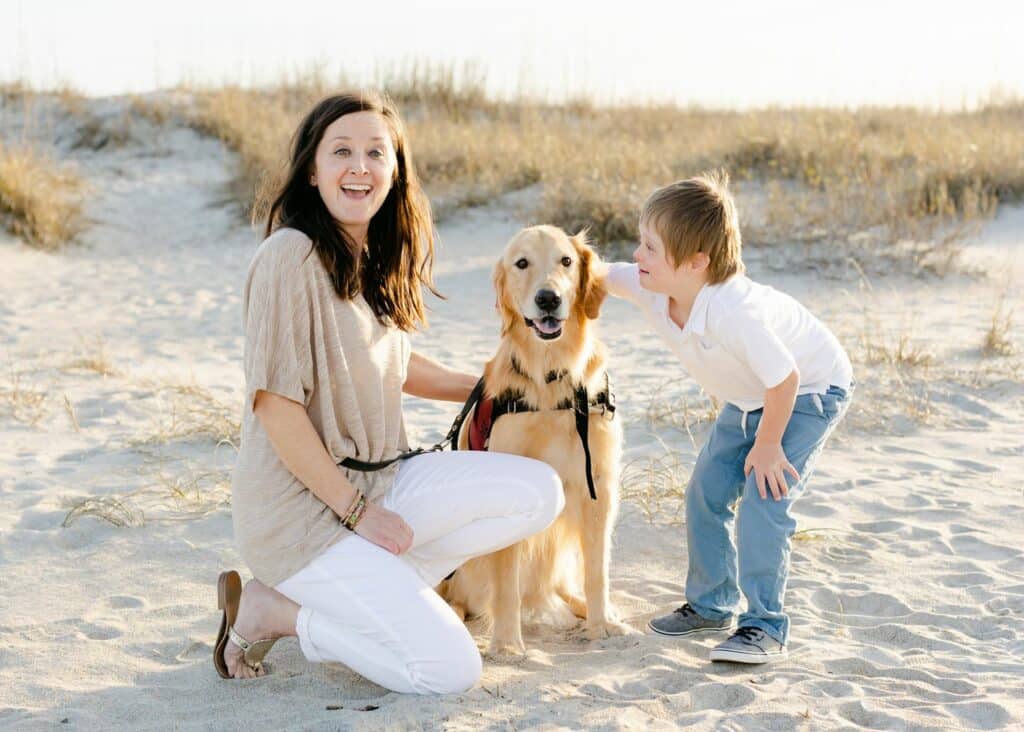
Paws4people®️
Types of Dogs Trained

Service Dogs
Dogs that are trained to perform a minimum of three (3) tasks to mitigate the effects of an individual’s physical, neurological, psychological, or other medical related disability or disabilities. The Service Dog provides help in conducting everyday life skills, thus enabling the Private Placement Client (PPC) to perform more independently than they otherwise would without their Assistance Dog.

Facility Dogs
Dogs that are trained and placed with a medical in a human services, medical, educational, or therapeutic field. This Private Placement Handler (PPH) will use the Facility Dog to perform Animal Assisted Interventions to support individuals with physical, neurological, psychological, intellectual, medical diagnosis,

Assistance Dogs Type II
An Assistance Dog Type II, or AD2, helps mitigate a Client’s disability within their home. Similar to an Emotional Support Dog, an AD2 does not have public access.

Emotional Support Dogs
Dogs that are specially trained to provide comfort to their handler(s) within their own home and other dog-friendly environments.
Learn More
Categories and Certifications
Service Dogs
Types of Assistance Dogs: Physical and/or Neurological Assistance Dog (PND)
*Primary Certification
Classifications of:
Classifications of Physical and/or Neurological Assistance Dogs (PND):
Mobility Assistance (MAD)
A Physical and/or Neurological Assistance Dog specially trained to enable individuals with equilibrium or vertigo, or mobility limitation related disabilities to lead a more independent life by providing balance, stability, and wheelchair support. In some instances, these dogs are trained for Laser Designated Retrieval work so the handler can point a laser pen at an item and thereby queue the dog to retrieve that item.
Sensory Development / Tactile Pressure (STP)
A Physical and/or Neurological Assistance Dog specially trained for individuals with developmental disabilities. These dogs are specifically trained to convey pressure, receive pressure, alert/distract from their handler’s vocal, movement, or motor tics, and alert someone nearby if their handler leaves a designated area. SPECIAL NOTE: paws4people does not tether-train dogs for Autism where dogs are actually bound to their handler, nor do we train personalized tracking and search capabilities.
Medical Alert Assistance Dog (MED)*
See additional MED Column
Classifications of:
Medical Alert Assistance Dogs (MED):
Psychiatric (PSY)
A Medical Alert Assistance Dog specially trained to enable individuals with psychiatric disabilities to lead more independent lives by performing tasks that the person otherwise could not do, or would have extreme difficulty doing for him/herself. The Private Placement Clients (PPC) for these dogs are generally under medical care or have been diagnosed with a psychological condition, with the most common diagnosis being: Post-Traumatic Stress (PTS), Complex-Post-Traumatic Stress (CPTS), Traumatic Brain Injury (TBI), and/or Military Sexual Trauma (MST), and various personality disorders. These dogs are trained to perform tasks such as search specific rooms before their handler enters, interrupt nightmares, alert their handler to someone approaching from behind, and detect changes in their handler’s cortisol levels, and physically interrupt disruptive episodes.
Allergen Detection (ALG)
A Medical Alert Assistance Dog specially trained to sniff out a particular substance based on an individual’s allergies. Once the dog detects the allergy substance, they are trained to alert their handler, or someone nearby, to notify them of the presence of the scent.
Incident Response (IRD)
A Medical Alert Assistance Dog trained to respond to an emergency situation, and then perform a pre-defined set of commands to provide notification of the individual’s condition. They may alert a family member or caregiver, retrieve emergency medications, or press a medical alert button. When assistance arrives the dog can be trained to open the door and direct the responder to the handler. These dogs are trained specifically to mitigate symptoms of numerous disabilities including seizures, brain aneurisms, or heart conditions. SPECIAL NOTE:These dogs are not specifically trained to pre-alert or sense an episode before it happens. However, in many instances, the dogs will learn to pre-alert over time although the PPC should not anticipate this to happen in every case.
Diabetes Alert (DAD)
A Medical Alert Assistance Dog specially trained to identify changes in scent as a result of hypoglycemia or abnormally low blood sugar and to alert the handler or a caretaker. Diabetes Alert Dogs are taught to recognize changes in the handler’s blood sugar level and alert the handler to check the level or take medication.
Hearing Alert (HRG)
A Medical Alert Assistance Dog trained to assist people with hearing disabilities by alerting them to everyday sounds – a ringing doorbell or a knock on the door, a telephone, an alarm clock, or a smoke detector. Outside, they may alert the handler to a siren sound, a vehicle’s back-up beep, or someone calling the handler’s name. Hearing Alert Dogs are trained to get the handler’s attention and lead the handler to the source of the sound.
Ambassador Dog (AMB)
These dogs are primarily used as Demonstration Dogs. Demonstration Dogs are “teachers,” who show our clients/handlers, trainers, staff, students, and volunteers, specific tasks, how each task should look when done correctly, and allow us to break down each task into teachable components. AD-AMBs are assigned to certified paws4people trainers.
Facility Dogs
A paws4people®️ Facility Dog is specially trained to work with a volunteer or professional who is trained to work with the dog. Facility Dogs are assigned to experienced handlers or professionals of a given facility, who control and utilize these dogs as they work within the environment.
Classifications of:
Facility Dogs
Rehabilitative Facility Dog (RFD)
A paws4people Rehabilitative Facility Dog (RFD) is specially trained to work within the confines of a physical rehabilitative treatment facility (inside or outside a hospital environment) to work with Physical Therapists, Occupational Therapists, Speech Pathologists, etc., providing therapeutic interventions, methodologies or protocols to patients with physical and/or neurological disabilities. These dogs are assigned to work with individual patients as part of their treatment team, and work under the orders of a medical doctor or other licensed medical health care provider. These dogs are specifically trained and highly experienced enabling them to establish and maintain a working relationship with multiple patients while working in very high stress environments.
Psychiatric Facility Dog (PFD)
A paws4people Psychiatric Facility Dog (PFD) is specially trained to work within the confines of a psychiatric treatment facility, to work with psychiatrists, psychologists, counselors, therapists, or social workers assisting in the psychoanalysis and/or psychotherapy for patients who have been diagnosed with a wide spectrum of physiological conditions/illnesses. These dogs provide therapeutic interventions, methodologies or protocols to patients with psychological and/or emotional disabilities. These dogs are assigned to work with individual patients as part of their psychological treatment team, and work under the orders of a medical doctor or other licensed mental health care provider. These dogs are specifically trained and highly experienced enabling them to establish and maintain a working relationship with multiple patients while working in very high stress environments.
Scent Detection (SCT)
A paws4people Scent Detection Facility Dog is specifically trained to provide medical and/or environmental aid by being trained to detect specific smells within their surrounding area. These dogs assist their handler in detecting a scent that the handler would otherwise not be able to locate on their own (i.e. bed bug detection, arson accelerant detection, etc.).
Crisis Response Dog (CRD)
A paws4people Crisis Response Dog (CRD) is trained to work with first responders such as firefighters, police officers, or EMTs. The dogs are trained to provide comfort in emergency situations both at the department/hospital or at the scene of the emergency. They are trained to ride in the vehicle with the first responder and to ease the distress of anyone affected by the trauma.
Canine-Assisted Education (CAE)
A paws4people Canine-Assisted Education Facility Dog is specially trained to perform inside the special and/or regular education classrooms or learning settings. These dogs assist teachers in performing their duties using a new educational tool – the dog. SPECIAL NOTE: The handler of a CAE Facility Dog must be a teacher or otherwise working within the scope of their profession within the school environment.
Classifications of:
Canine-Assisted Education (CAE) Dogs
General Education
These dog/handler teams are trained to work within classrooms that contain a 90% or higher composition of non-IEP (special education) students.
Special Education
These dogs must be able to handle classroom and special education environments, as well as be able to work with students having all types of physical, neurological, psychiatric, emotional disabilities and/or behavioral problems.
R.E.A.D.
This is a secondary classification level and dog/handler team must be certified in either General or Special Education training. Visits are conducted in a classroom or library in which a reading-based literacy program is being conducted. SPECIAL NOTE: The handler and dog MUST be R.E.A.D. certified.
Assistance Dogs Type II
AD2s require a minimum 10 hours of in-home task training with a paws4people staff trainer, and they recertify annually just as the Service and Facility Dogs do. AD2s are beneficial to Clients who need the assistance of a specially trained dog in their home, but they do not need them in public settings. Some examples of tasks performed by AD2s are: deep pressure therapy, behavior interruption, item retrieval, and more.
Emotional Support Dogs
Emotional Support Dogs are not trained for public access or any travel training protocol. They are extensively trained with basic obedience, advanced obedience and, in some instances, disability skills, commands and behaviors. They are trained to provide comfort to their handler(s) while in their home and other dog-friendly environments.

